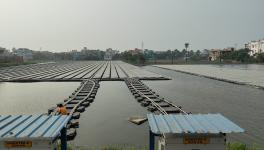'Bury Electric Cables' to Save Great Indian Bustards from Extinction, Suggests Research
Burying electric cables is the only and most effective solution to save the Great Indian Bustards (GIB)--the single population of the bird species struggling for its survival in India, suggests a study by the Wildlife Institute of India (WII). It also advised that authorities should avoid future overhead installations in bustard habitats.
A team of scientists from the Wildlife Institute of India revealed their findings based on the adverse impact of electricity supply lines on wildlife habitat in the Thar desert in Rajasthan. The research plugged the lack of evidence impeding the mitigation measures in tropical developing countries. The energy companies were also averting taking action in this matter because of the scarcity of evidence.
The WII study was part of the Institute's Bustard Recovery Program, which is funded by the National Compensatory Afforestation Fund Management and Planning Authority of the Government of India, along with an additional grant from the Rajasthan State Pollution Control board.
"Marking wires with bird diverters to make them conspicuous, reducing the number of wires, transfiguration from vertical to horizontal alignments, and rerouting can reduce mortality. However, these measures can reduce mortality and success of wire marking is limited to the bustards, although it reduces causalities by half for birds as a whole," the study says.
It adds, "Although this is costly, we recommend implementing this measure and avoiding future power infrastructure in priority GIB habitats. Without this, ongoing conservation measures will not succeed. While wire marking is reasonable mitigation for low risk and general wildlife, it is insufficient for GIB."
The WII team assessed power line induced bird mortality in 4,200 sq km area of the Thar desert. They searched for carcasses in 2,000 x 60 sq mt belts along 40 randomly selected power lines over six multi-season surveys and in 20 control transects that were surveyed once. The scientists examined the effect of "power line mortality" (death due to power distribution lines) on the population viability of the critically endangered Great Indian Bustard (GIB). There are only around 150 GIB birds surviving in India.
"Mortality was positively related to number of wires. Large-bodied and ground-dwelling families like GIB were most vulnerable to power line mortality. We estimated 87,966 bird mortalities per year in the study area. These findings bear global conservation implications since the Thar desert supports 14 threatened and 65 migratory species of the Central Asian Flyway. The population viability analysis revealed that the Great Indian Bustard is at imminent risk of extinction due to power line mortality, and calls for urgent mitigation of overhead power cables and the avoidance of future overhead installations in bustard habitat," the study says.
The land cover of Thar desert falls under grasslands/savannahs, bare sand dunes, vegetated dunes, barren flatlands and agricultural areas. Thar landscape is also the most densely populated desert globally, with 84 humans per sq km, many surviving below the poverty line. The availability of wind thermals alongside large, open, less productive and free spaces have attracted many wind turbines and solar plants in the last decade. Consequently, power lines have expanded rapidly.
"We, the scientists' team presented the first comprehensive study of avian mortalities from this region, where we estimated mortality rates, corrected for scavenging/decomposition and habitat/detection biases to assess the magnitude of the problem; examined the influence of habitat and power line characteristics on mortality to inform mitigation plans; assessed relative vulnerability vis-à-vis family traits to generate taxonomic risk profiles; and quantified the effect of power lines on the persistence of the great Indian bustard through population viability analysis, as a case study," the study mentions.
Dr YV Jhala, senior WII scientist and part of the team, told NewsClick, "The country needs economic development but not at the cost of the biodiversity loss. Species like GIB is drastically declining because of the species' slow life-history traits and its inability to maintain a viable population in the face of human-induced mortality and habitat loss."
He said the only viable population of GIB now exists in the Thar desert, which is fast emerging as a new hub for renewable energy production. These new alarming situations call for factoring biodiversity concerns into land-use policy. "We hope that our approach and results of the joint study will assist and inform policymakers in taking along biodiversity concerns with economic needs," he said.
The expansion of powerline networks is moving at the rate of 5% annually to landscapes shared with wildlife. Consequently, overhead wires lead to avian mortalities through collision and electrocution, making them a global conservation problem.
Research on bird mortality due to power lines is primarily limited to Europe and North America, with some exceptions. The lack of primary information from the Indian subcontinent is particularly concerning since its growing economy and dense human population share space with rich biodiversity and migratory flyways, leading to an increasing interface between power lines and birds. Finally, studies based on carcass surveys underreport the truth, says the study.
"Unfortunately, arid ecosystems of India is misconstrued as 'wastelands' and the projects that come under the renewable power ambit, conceived as ecologically beneficial, escape the scrutiny of environmental laws," MK Ranjitsinh, legendary conservationist, told NewsClick.
According to a report published in NewsClick earlier, Sumit Dookia, a wildlife biologist at Guru Gobind Singh Indraprastha University in New Delhi, stressed the need to frame environmental guidelines for assessing impacts of renewable energy projects on schedule I species under the Wildlife Protection Act and those recognised as 'critically endangered' and 'endangered' in the IUCN red list."
Ranjit sinh was among the environmentalists who had approached the apex court in 2019 seeking protection and conservation of two bird species–GIB and Lesser Florican. They contended that the near-extinct species were getting killed due to collision with the overhead power lines. So, the court had directed the states of Gujarat and Rajasthan to shift the existing overhead power lines from the priority and potential habitats of GIB to underground power lines. The apex court also directed that all future power lines have to be installed as underground cables.
However, a media report highlighted how power line companies were not complying with the SC order to install new bird diverters on power lines. These companies were reportedly seeking revision of the judgment, which would cause further delay in implementing the court order.
The high mortality of GIB will be disastrous for humanity. Their elimination will disrupt ecosystem services such as seed dispersal, pollination, predation, and pest control. Bustards serve as the flagship species of dryland. Burying cables will not only enhance their population viability but will also help maintain the ecological functions of birds.
Get the latest reports & analysis with people's perspective on Protests, movements & deep analytical videos, discussions of the current affairs in your Telegram app. Subscribe to NewsClick's Telegram channel & get Real-Time updates on stories, as they get published on our website.
























